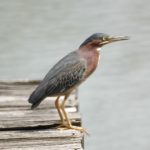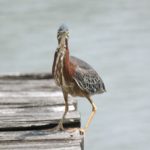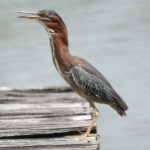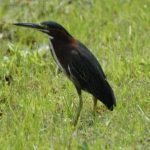Green Heron
Butorides Virescens
The Green Heron (Butorides virescens) is a small heron. Some sources consider this bird and the Striated Heron or Mangrove Heron, Butorides striatus, of tropical Africa and Asia, to be a single species, the Green-backed Heron.
Adults are about 44 cm long and have a blue back and wings, a chestnut neck with a white line down the front, a black cap and short yellow legs. Juveniles are duller, with the head sides, neck and underparts streaked brown and white and greenish-yellow legs.
Their breeding habitat is small wetlands in eastern and midwest North America, Central America, the West Indies and the Pacific coast of Canada and the United States. They nest in a platform of sticks often in shrubs or trees, sometimes on the ground, often near water. The female lays 3 to 5 eggs. Both parents incubate for about 20 days until hatching and feed the young birds which take a further 3 weeks to fledge.
Northern Green Heron populations of the race B. v. virescens are migratory and winter from the southern United States through to northern South America. This subspecies is an extremely rare vagrant to western Europe.
Resident breeding birds in the Caribbean and Central America belong to the shorter-winged race B. v. maculatus.
Green Herons stand still at the water’s edge and wait to ambush prey. They mainly eat small fish, frogs, and aquatic insects. They sometimes drop food on the water’s surface to attract fish. Their call is a loud and sudden kyow.
The text within the green border is licensed under the GNU Free Documentation License. To see the full article with more information, visit the Wikipedia article “Green Heron “. All content outside the green border is copyrighted by McBryde Website Design.
For more information from the USGS (United States Geological Survey)
on the Green Heron





